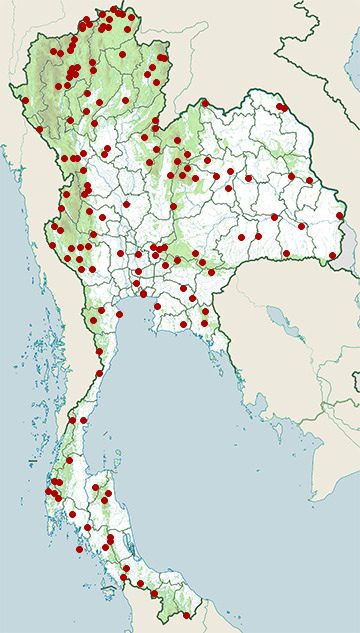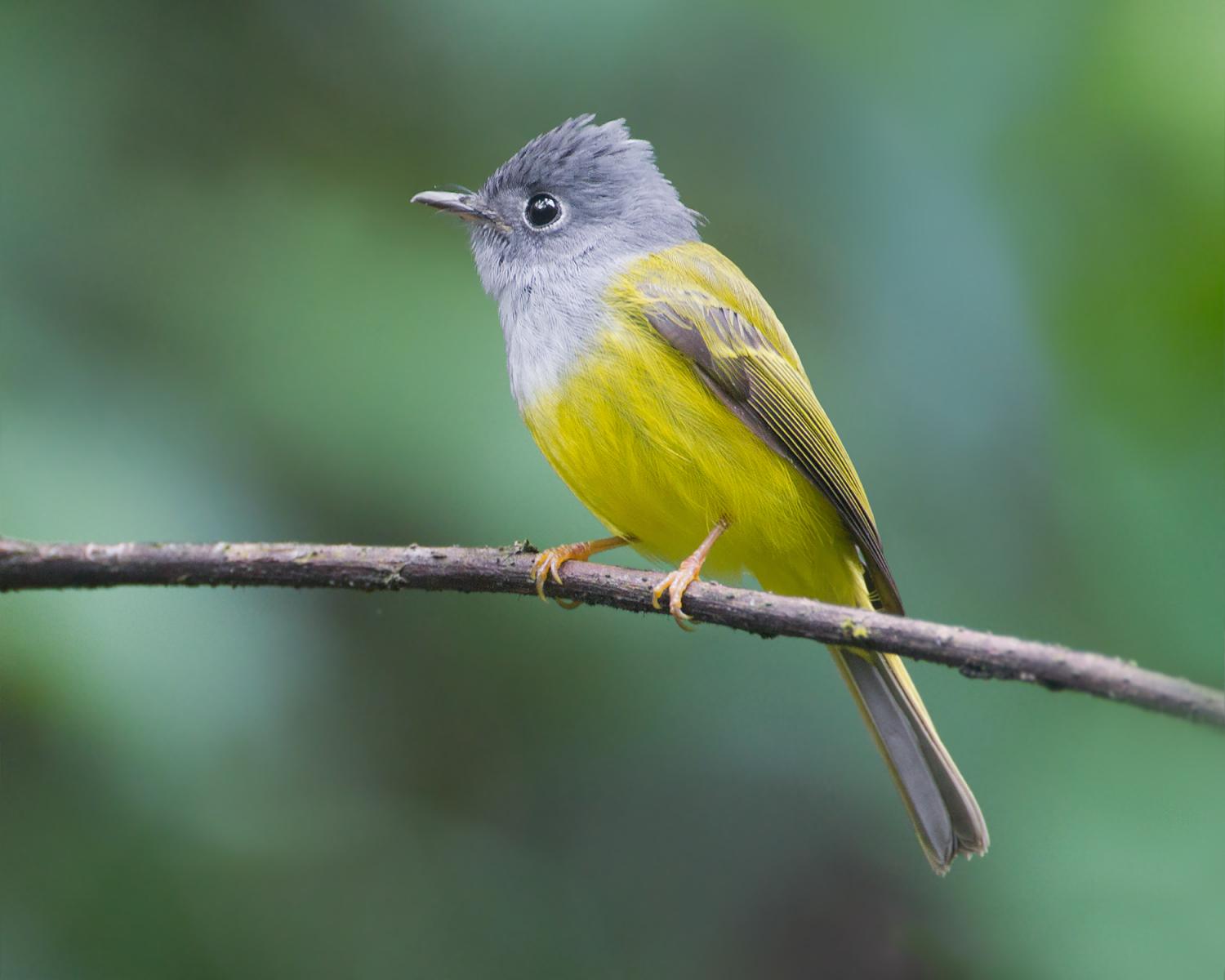Species of Thailand
Grey-headed canary-flycatcher
Culicicapa ceylonensis
William John Swainson, 1820
In Thai: นกจับแมลงหัวเทา
The grey-headed canary-flycatcher (Culicicapa ceylonensis), sometimes known as the grey-headed flycatcher, is a species of small flycatcher-like bird found in tropical Asia. It has a square crest, a grey hood and yellow underparts. They are found mainly in forested habitats where they often join other birds in mixed-species foraging flocks. Pairs are often seen as they forage for insects by making flycatcher-like sallies and calling aloud. Several subspecies are recognized within their wide distribution range. In the past the genus Culicicapa was considered to be an Old World flycatcher but studies have found them to belong to a new family designated as the Stenostiridae or fairy flycatchers that include the African genera Stenostira and Elminia.
Description
The grey-headed canary-flycatcher is about 12–13 cm long with a squarish grey head, a canary yellow belly and yellowish-green upperparts. They forage actively like flycatchers and perches in a very upright posture. The sexes are indistinguishable in plumage. They have a very flat bill (which gave it the earlier genus name of Platyrhynchus) which when seen from above look like an equilateral triangle and is fringed with long rictal bristles.
Across their range, populations differ in the shades of the colours and vary slightly in dimensions and several of these have been designated as subspecies. The nominate subspecies breeds in peninsular India in the hills of the Western Ghats, Nilgiris, central India and the Eastern Ghats (Lammasingi) and Sri Lanka. Subspecies calochrysea first described by Harry Oberholser in 1923 breeds along the Himalayas east to Myanmar and Thailand and winters across southern India. The nominate form is darker in shade. Subspecies antioxantha which was also described by Oberholser has a breeding range from southern Burma, Thailand through Malaysia to Java and Bali. The island population sejuncta described by Ernst Hartert in 1897 is found on Sumbawa, Flores and possibly on Lombok while connectens described by Bernhard Rensch in 1931 is restricted to the island of Sumba.
The grey-headed canary-flycatcher was earlier considered to be an Old World flycatcher in spite of its odd crest, colours and nature of vocalization. Molecular phylogeny studies however show that they are quite different and have been placed in the family Stenostiridae that is closely related to the tits and penduline-tits.
Habitat and distribution
This species breeds in upland to montane oak (Quercus) and other broadleaved forests and similar wooded areas in temperate to tropical southern Asia, from Pakistan, Central India, Bangladesh and Sri Lanka east to Indonesia and southern China. Many populations are resident, but some Himalayan birds are partial migrants that winter in peninsular India sometimes even occurring in arid habitats. Other populations may make altitudinal movements but in parts of the eastern Himalayas such as Bhutan, they have been found to occur all year round, and can be found up to and above 2, 000 m ASL. During the non-breeding season, they are seen in the plains and lower elevations (September to March in India) when they prefer well wooded areas of relatively mature secondary forests, abandoned plantations and overgrown gardens, usually near water and streams including wooded gorges. They are very active and noisy throughout the day foraging at all levels of the forest.
Behaviour and ecology
The grey-headed canary-flycatcher is an insectivore and like flycatchers makes sallies for aerial insects from a low perch under the canopy of a tree. A pair may forage together and they will often join mixed-species foraging flocks. They breed in summer (April to June in India and possibly later in western China. The nest, built by the female alone, is an unlined cup bound by cobwebs and often attached to and covered by moss. The nest is found placed against the mossy trunk of a tree or built on rocks or on a ledge in a mud bank. The typical clutch is three or four eggs. Hodgson's hawk-cuckoo has been observed parasitizing the brood of this species in northern Borneo.
This article uses material from Wikipedia released under the Creative Commons Attribution-Share-Alike Licence 3.0. Eventual photos shown in this page may or may not be from Wikipedia, please see the license details for photos in photo by-lines.
Category / Seasonal Status
BCST Category: Recorded in an apparently wild state within the last 50 years
BCST Seasonal statuses:
- Resident or presumed resident
- Non-breeding visitor
Scientific classification
- Kingdom
- Animalia
- Phylum
- Chordata
- Class
- Aves
- Order
- Passeriformes
- Family
- Stenostiridae
- Genus
- Culicicapa
- Species
- Culicicapa ceylonensis
Common names
- Thai: นกจับแมลงหัวเทา
Synonyms
- Platyrhynchus ceylonensis (protonym)
Conservation status

Least Concern (IUCN3.1)
Photos
Please help us review the bird photos if wrong ones are used. We can be reached via our contact us page.
Range Map

- Ban Phai District, Khon Kaen
- Bang Pahan District, Phra Nakhon Si Ayutthaya
- Bang Phra Non-Hunting Area
- Bang Pu Recreation Centre
- Bangkok Province
- Bueng Boraped Non-Hunting Area
- Bueng Khong Long Non-Hunting Area
- Chae Son National Park
- Chaloem Phra Kiat District, Saraburi
- Chaloem Rattanakosin National Park
- Chat Trakan Waterfall National Park
- Chiang Dao District, Chiang Mai
- Chiang Dao Wildlife Sanctuary
- Chiang Khong District, Chiang Rai
- Chiang Saen District, Chiang Rai
- Doi Chong National Park
- Doi Inthanon National Park
- Doi Lang
- Doi Lo District, Chiang Mai
- Doi Pha Hom Pok National Park
- Doi Phu Kha National Park
- Doi Suthep - Pui National Park
- Erawan National Park
- Fang District, Chiang Mai
- Hala-Bala Wildlife Sanctuary
- Hang Chat District, Lampang
- Huai Kha Khaeng Wildlife Sanctuary
- Huai Nam Dang National Park
- Huai Sala Wildlife Sanctuary
- Huai Talat Reservoir Non-Hunting Area
- Huai Yang Waterfall National Park
- Kaeng Khoi District, Saraburi
- Kaeng Krachan National Park
- Kaeng Krung National Park
- Kanthararom District, Sisaket
- Kantharawichai District, Maha Sarakham
- Kapong District, Phang Nga
- Kaset Sombun District, Chaiyaphum
- Khao Ang Rue Nai Wildlife Sanctuary
- Khao Banthat Wildlife Sanctuary
- Khao Khitchakut National Park
- Khao Laem National Park
- Khao Luang National Park
- Khao Nam Khang National Park
- Khao Nan National Park
- Khao Phanom Bencha National Park
- Khao Phra - Bang Khram Wildlife Sanctuary
- Khao Pu - Khao Ya National Park
- Khao Soi Dao Wildlife Sanctuary
- Khao Sok National Park
- Khao Yai National Park
- Khlong Lan National Park
- Khlong Wang Chao National Park
- Khon San District, Chaiyaphum
- Khun Chae National Park
- Khun Korn Forest Park
- Khun Nan National Park
- Khun Tan District, Chiang Rai
- Klaeng District, Rayong
- Ko Lanta National Park
- Kui Buri National Park
- Laem Pak Bia
- Lam Nam Kok National Park
- Lan Sang National Park
- Mae Ai District, Chiang Mai
- Mae Chan District, Chiang Rai
- Mae Charim National Park
- Mae Fa Luang District, Chiang Rai
- Mae Moei National Park
- Mae Ping National Park
- Mae Rim District, Chiang Mai
- Mae Sai District, Chiang Rai
- Mae Sot District, Tak
- Mae Tha, Lampang District, Lampang
- Mae Wong National Park
- Muak Lek District, Saraburi
- Mueang Chiang Mai District, Chiang Mai
- Mueang Chiang Rai District, Chiang Rai
- Mueang Chumphon District, Chumphon
- Mueang Kanchanaburi District, Kanchanaburi
- Mueang Khon Kaen District, Khon Kaen
- Mueang Nakhon Nayok District, Nakhon Nayok
- Mueang Nan District, Nan
- Mueang Sukhothai District, Sukhothai
- Mueang Suphanburi District, Suphan Buri
- Mueang Surin District, Surin
- Mueang Tak District, Tak
- Nam Nao National Park
- Nam Phong National Park
- Namtok Sam Lan National Park
- Nong Bong Khai Non-Hunting Area
- Nong Ya Plong District, Phetchaburi
- Op Khan National Park
- Pae Mueang Pee Forest Park
- Pai District, Mae Hong Son
- Pang Sida National Park
- Pang Sila Thong District, Kamphaeng Phet
- Pha Daeng National Park
- Pha Hin Ngam National Park
- Pha Nam Yoi Forest Park
- Pha Taem National Park
- Phu Chong Na Yoi National Park
- Phu Hin Rong Kla National Park
- Phu Khiao Wildlife Sanctuary
- Phu Kradueng National Park
- Phu Langka National Park
- Phu Luang Wildlife Sanctuary
- Phu Sa Dok Bua National Park
- Phu Soi Dao National Park
- Phu Suan Sai National Park
- Phu Toei National Park
- Phu Wiang National Park
- Ramkhamhaeng National Park
- Rattanaburi District, Surin
- Sai Yok District, Kanchanaburi
- Sai Yok National Park
- Sakaerat Environmental Research Station
- Salawin National Park
- Samut Prakan Province
- San Kala Khiri National Park
- San Sai District, Chiang Mai
- Sanam Chai Khet District, Chachoengsao
- Sangkhla Buri District, Kanchanaburi
- Sangkhom District, Nong Khai
- Si Satchanalai National Park
- Si Sawat District, Kanchanaburi
- Sri Nakarin Dam National Park
- Sri Phang-nga National Park
- Tai Rom Yen National Park
- Taksin Maharat National Park
- Takua Pa District, Phang Nga
- Tat Mok National Park
- Thale Ban National Park
- Tham Pratun Non-Hunting Area
- Tham Sakoen National Park
- Thap Lan National Park
- Thong Pha Phum National Park
- Thung Salaeng Luang National Park
- Thung Yai Naresuan Wildlife Sanctuary
- Ton Nga-Chang Wildlife Sanctuary
- Ton Pariwat Wildlife Sanctuary
- Umphang Wildlife Sanctuary
- Wang Mai Forest Restoration Project
- Wat Phai Lom & Wat Ampu Wararam Non-Hunting Area
- Wiang Lo Wildlife Sanctuary
- Yan Ta Khao District, Trang


